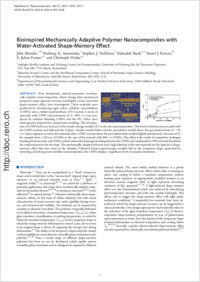Bioinspired mechanically adaptive polymer nanocomposites with water-activated shape-memory effect
- Mendez, Julie Adolphe Merkle Institute and Fribourg Center for Nanomaterials, University of Fribourg, Switzerland
- Annamalai, Pratheep K. Adolphe Merkle Institute and Fribourg Center for Nanomaterials, University of Fribourg, Switzerland
- Eichhorn, Stephen J. Materials Science Centre and the Northwest Composites Centre, School of Materials, Paper Science Building, University of Manchester, U.K.
- Rusli, Rafeadah Materials Science Centre and the Northwest Composites Centre, School of Materials, Paper Science Building, University of Manchester, U.K.
- Rowan, Stuart J. Department of Macromolecular Science and Engineering, Case Western Reserve University, United States
- Foster, E. Johan Adolphe Merkle Institute and Fribourg Center for Nanomaterials, University of Fribourg, Switzerland
- Weder, Christoph Adolphe Merkle Institute and Fribourg Center for Nanomaterials, University of Fribourg, Switzerland
-
03.08.2011
Published in:
- Macromolecules. - 2011, vol. 44, no. 17, p. 6827–6835
English
New biomimetic, stimuli-responsive mechanically adaptive nanocomposites, which change their mechanical properties upon exposure to water and display a water-activated shape-memory effect, were investigated. These materials were produced by introducing rigid cotton cellulose nanowhiskers (CNWs) into a rubbery polyurethane (PU) matrix. A series of materials with CNW concentrations of 2–20% v/v was produced by solution blending CNWs and the PU. Films were subsequently prepared by compression molding. The introduction of CNWs led to an increase of the tensile storage moduli (E′) in the dry nanocomposites. The level of reinforcement scaled with the CNW content and followed the Halpin–Kardos model below and the percolation model above the percolation limit of ∼7% v/v. Upon exposure to water, the materials with a CNW content above the percolation limit swelled slightly and showed a decrease of E′, for example from 1 GPa to 144 MPa in the case of the material with 20% v/v CNWs. This effect is the result of competitive hydrogen bonding between water and CNWs, which reduces the hydrogen bonding between the CNWs and weakens the CNW network that drives the reinforcement in the dry state. The mechanically adaptive behavior and a high elasticity of the wet materials are the basis for a shape-memory effect that uses water as the stimulus. Polarized Raman spectroscopy revealed that in the temporary shape, generated by stretching and drying water-swollen nanocomposites, the CNWs display a significant level of uniaxial orientation.
- Faculty
- Faculté des sciences et de médecine
- Department
- AMI - Chimie des polymères et matériaux
- Language
-
- English
- Classification
- Physics
- License
-
License undefined
- Identifiers
-
- RERO DOC 27393
- DOI 10.1021/ma201502k
- Persistent URL
- https://folia.unifr.ch/unifr/documents/302040
Statistics
Document views: 127
File downloads:
- pdf: 407
